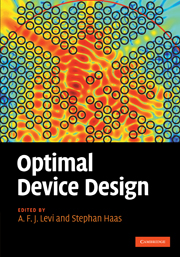Book contents
- Frontmatter
- Contents
- Preface
- Acknowledgements
- 1 Frontiers in device engineering
- 2 Atoms-up design
- 3 Electron devices and electron transport
- 4 Aperiodic dielectric design
- 5 Design at the classical–quantum boundary
- 6 Robust optimization in high dimensions
- 7 Mathematical framework for optimal design
- 8 Future directions
- Appendix A Global optimization algorithms
- About the authors
- Index
Preface
Published online by Cambridge University Press: 04 May 2010
- Frontmatter
- Contents
- Preface
- Acknowledgements
- 1 Frontiers in device engineering
- 2 Atoms-up design
- 3 Electron devices and electron transport
- 4 Aperiodic dielectric design
- 5 Design at the classical–quantum boundary
- 6 Robust optimization in high dimensions
- 7 Mathematical framework for optimal design
- 8 Future directions
- Appendix A Global optimization algorithms
- About the authors
- Index
Summary
Dramatic advances in the control of physical systems at the atomic scale have provided many new ways to manufacture devices. An important question is how best to design these ultra-small complex systems. Access to vast amounts of inexpensive computing power makes it possible to accurately simulate their physical properties. Furthermore, high-performance computers allow us to explore the large number of degrees of freedom with which to construct new device configurations. This book aims to lay the groundwork for a methodology to exploit these emerging capabilities using optimal device design. By combining applied mathematics, smart computation, physical modeling, and twenty-first-century engineering and fabrication tools it is possible to find atomic and nanoscale configurations that result in components with performance characteristics that have not been achieved using other methods.
Imagine you want to design and build a novel nanoscale device. How would you go about it? A conventional starting point is to look at a macroscopic component with similar functionality, and consider ways to make it smaller. This approach has several potential pitfalls. For one, with continued reduction in size, device behavior will become quantum in character where classical concepts and models cease to be applicable. Moreover, it is limited by ad hoc designs, typically rooted in our unwillingness to consider aperiodic configurations, unless absolutely mandated by physical constraints. Most importantly this conventional approach misses the enormous opportunity of exploring the full landscape of possible system responses, offered by breaking all conceivable symmetries.
Computational resources, realistic physical models, and advanced optimization algorithms now make it possible to efficiently explore the properties of many more configurations than could be tested in a typical laboratory.
- Type
- Chapter
- Information
- Optimal Device Design , pp. ix - xPublisher: Cambridge University PressPrint publication year: 2009

